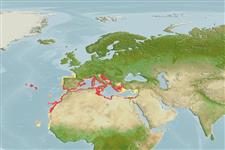Common names from other countries
Environment: milieu / climate zone / depth range / distribution range
Ecologie
; diepteverspreiding 4 - 100 m (Ref. 4). Subtropical, preferred 20°C (Ref. 107945); 46°N - 13°N, 32°W - 36°E (Ref. 4)
Eastern Atlantic and the Mediterranean: from Lisbon, Portugal to Senegal, and the Mediterranean.
Length at first maturity / Size / Gewicht / Leeftijd
Maturity: Lm ? range ? - ? cm Max length : 45.0 cm TL mannelijk/geslacht niet bekend; (Ref. 4); common length : 36.0 cm TL mannelijk/geslacht niet bekend; (Ref. 441)
Carapace length: 12 cm.
Life cycle and mating behavior
Geslachtsrijpheid | Voortplanting | Kuitschieten | Eieren | Fecundity | Larven
Ovigerous females from June to August (Ref. 4).
Holthuis, L.B. 1991. (Ref. 4)
Status op de Rode Lijst van het IUCN (Ref. 130435: Version 2024-1)
Status bij CITES (Ref. 108899)
Not Evaluated
Not Evaluated
Gebruik door de mens
Visserij: commercieel
FAO - Visserij: landings | FishSource | Sea Around Us
Tools
Internet-bronnen
Estimates based on models
Preferred temperature
(Ref.
115969): 14.6 - 21.6, mean 18.7 (based on 246 cells).
Weerstandsvermogen
Gemiddeld, minimale populatieverdubbelingstijd 1,4-4,4 jaar (K=0.2).
Kwetsbaarheid
Moderate to high vulnerability (48 of 100).
